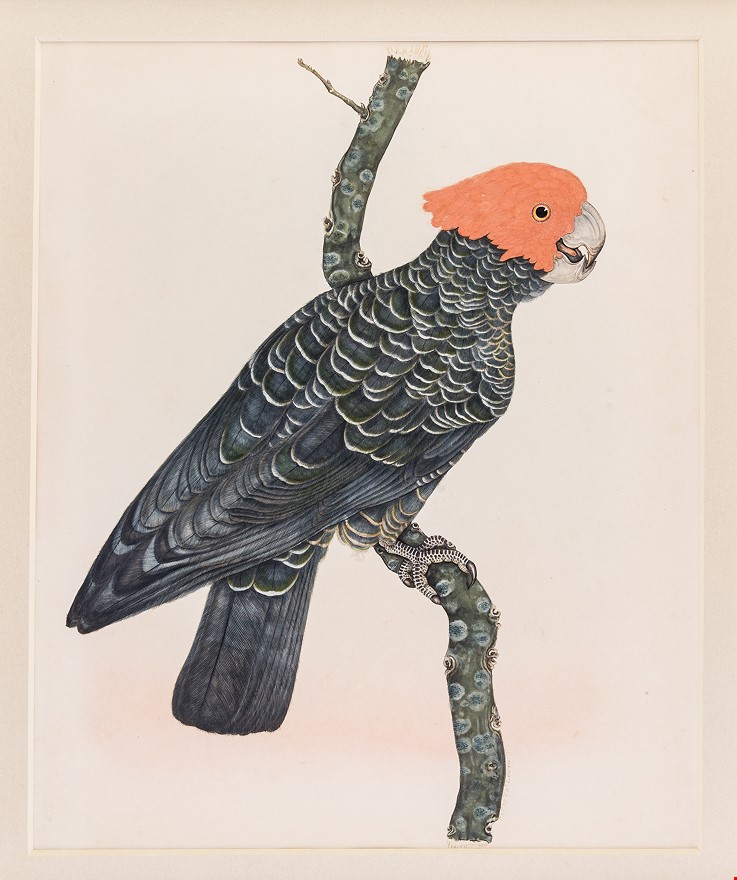A Gang-gang Cockatoo (Callocephalon fimbriatum).
LEWIN Thomas (1829].)
£32500.00
A Gorgeous Watercolour by One of the Lewin Brothers
Body colour, water colour with touches of gum arabic, and pen and grey ink on paper watermarked J. Watman. Measuring 440 by 330m. Framed and glazed. Signed and dated “l.r. D & P by Thos. Lewin 182 9?.” Inscribed in brown ink verso: "Species from New Holland (very scarce) Lewin. [And in pencil] Drawn and painted /from Nature and Correct/ siz Colours and all Honors(?) Lewin Jany 18. 1829." [London,
A wonderful example of an Australian gang-gang cockatoo by Thomas Lewin, who was the son of William Lewin (1747-1795) and brother of John William Lewin (1770-1819). The bird is perched on a branch, beak slightly open, the delicate line and colour is excellent, entirely in keeping with this eminent family's talent.
The gang-gang cockatoo inhabits the south-west coastal regions of Australia - Victoria, the Australian Capital Territory (ACT) and the southern part of NSW. It is the faunal emblem of the ACT. The first specimen of the gang-gang cockatoo was sighted (and shot) in 1801 on Churchill Island by one of the crew from The Lady Nelson, which was on a coastal surveying voyage under the command of James Grant. The artist's brother, John Lewin, was actually on that voyage. However, he travelled in the sister ship, Bee, which was forced to turn back in inclement weather. The gang-gang cockatoo is quite a hardy bird and often survived the voyage back to England. The interest in specimens from the New World was intense and several wealthy collectors established their own menageries, so there's every chance that Thomas Lewin drew this from a live specimen.
The Lewin family had an abiding interest in ornithology and connections to Australia. On moving to Kent, William Lewin befriended John Latham who has been described as the "grandfather of Australian ornithology." Their friendship was such that Lewin dedicated his masterpiece The Birds of Great Britain, with their eggs, accurately figured (7 vols., 1789–94) to Latham. His clearly talented sons, John William and Thomas, who were also collectors and illustrators, helped their father with the second edition of Birds of Great Britain... Just as John and Thomas worked together on their father's work, they continued this relationship while John was abroad.
Armed with a recommendation from the Home Secretary to then Governor John Hunter, John Lewin travelled to Australia in 1798 and became one of the best know artists of that era. In addition to landscapes, portraits of settlers, and miniatures, he painted much of the environment around him, including portraits of Australian Aborigines, and studies of birds, insects and plants. Such was his talent that Governor Macquarie became one of his patrons. Lewin published his first book in 1805, Prodromus Entomology: Natural History of Lepidopterous Insects of New South Wales. His second, published in London in 1808 was the Birds of New Holland, with their Natural History.
ODNB clarifies the brothers' working relationship: "The London editions of his books were supervised and edited by his brother Thomas Lewin, who also wrote the prefaces and arranged contributions from scientific experts." In 1813 John had George Howe (Australia's first government printer) print a new edition of Birds of New Holland, this time called Birds of New South Wales. It was the first illustrated book to be published in Australia.
Penny Olsen, Feather and Brush: Three Centuries of Australian Bird Art. (Melbourne, 2001) p42; Richard Nevill, Mr. J.W. Lewin, Painter and Naturalist. (Sydney, 2012).
Stock Code: 228727




